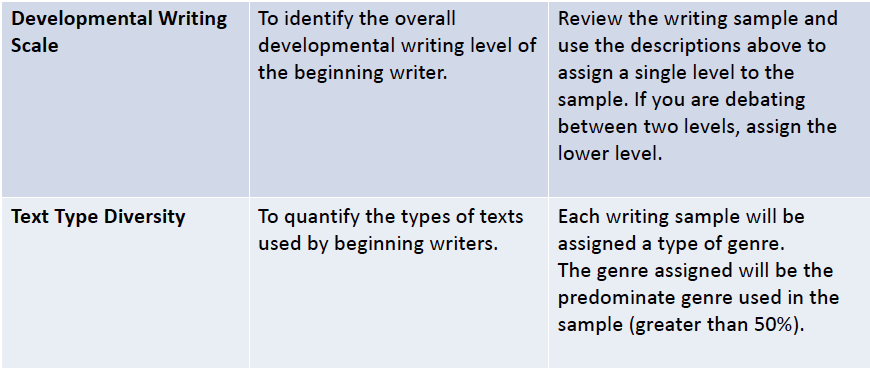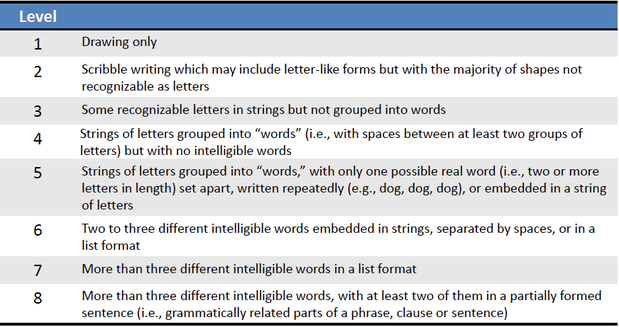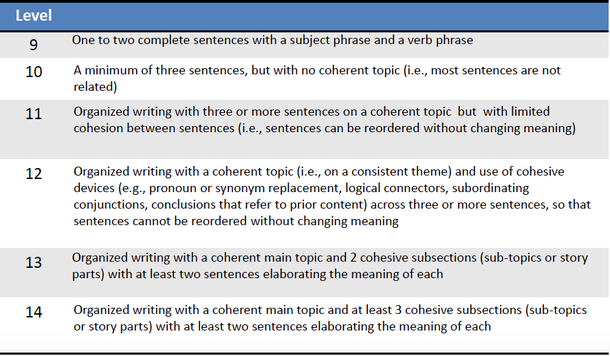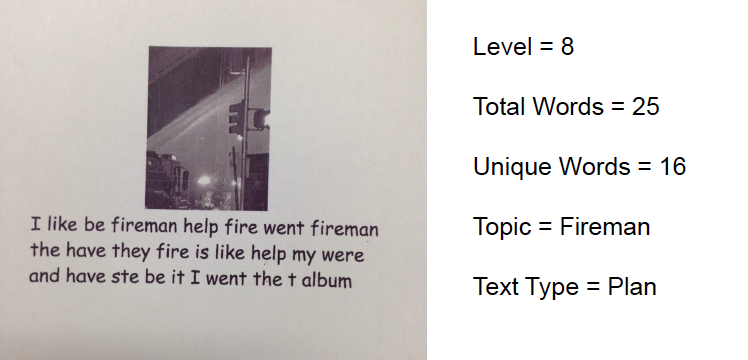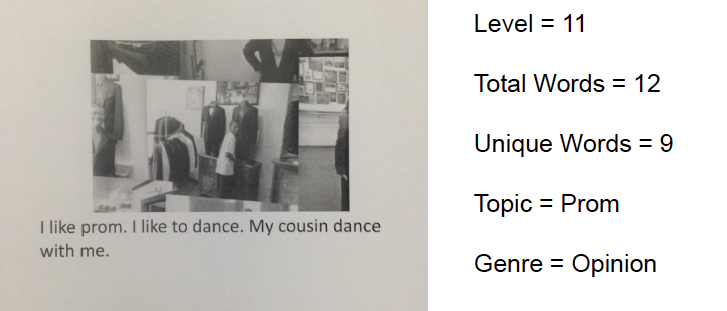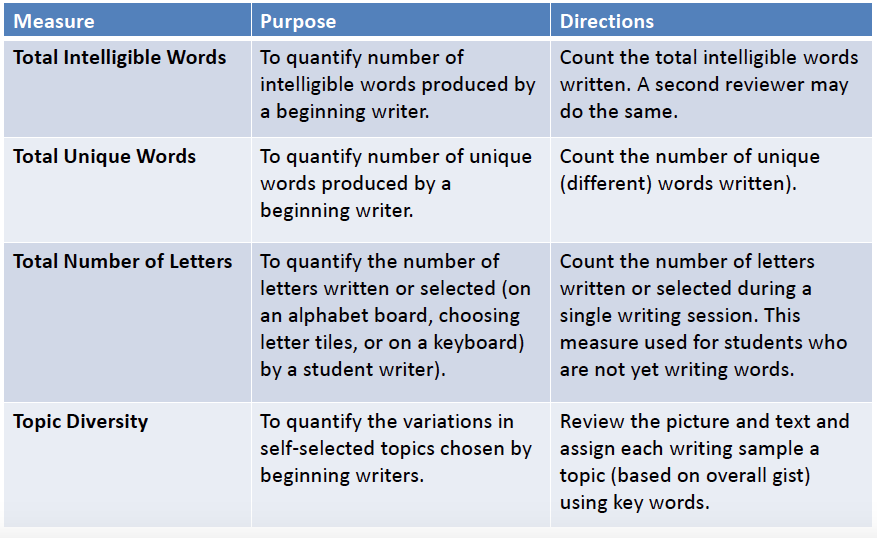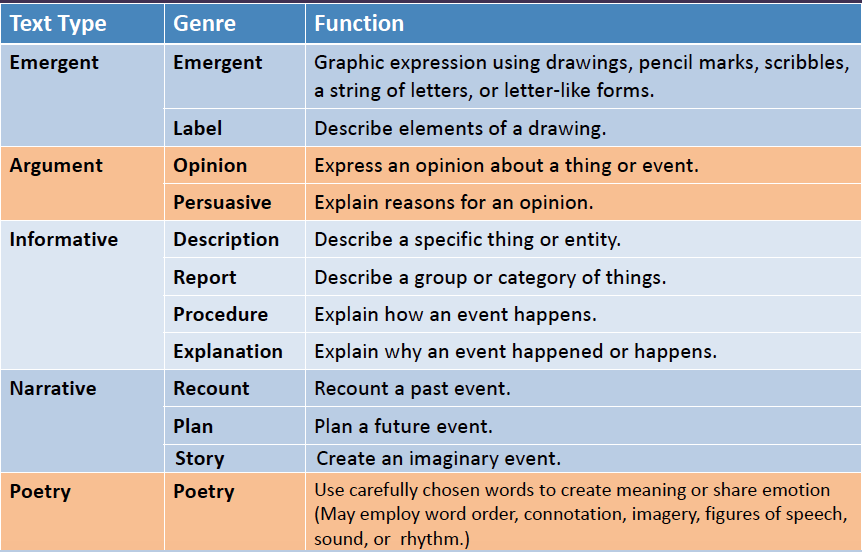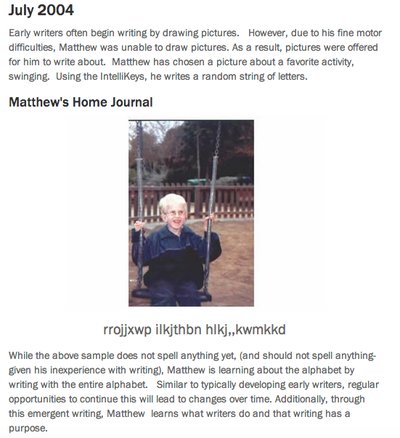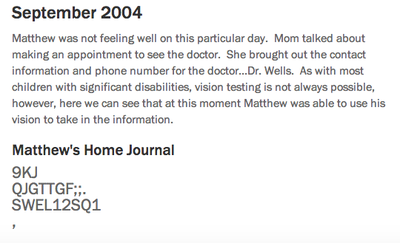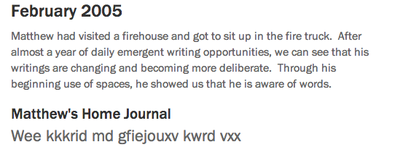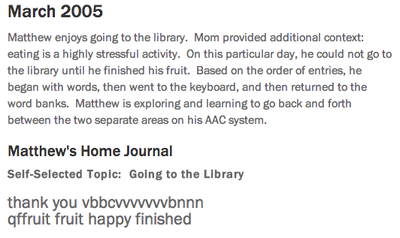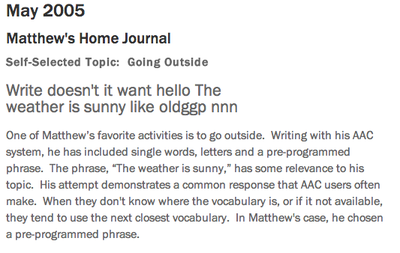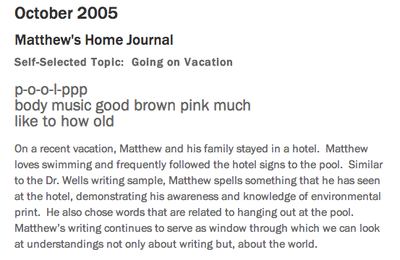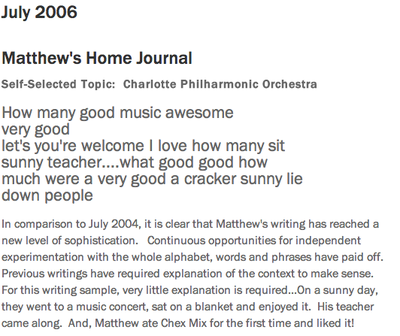What can assessment look like?
|
The Developmental Writing Scale for Beginning Writers (DWS) is a set of writing quantity and quality measures. It is a 14-point ordinal scale which ranges from emergent writing (scribbling) to cohesive and coherent paragraph level writing (Sturm, Cali, Nelson, Staskowski, 2012). It was developed to be sensitive to small changes in writing quality in beginning writers. A second measure, Text Type Diversity (Cali & Sturm, 2010) was developed to assess genre production (e.g., personal narratives, stories, opinions, plans) of beginning writers. These measures are meant to be used to identify individualized goals and show progress for students with significant disabilities.
|
The PDF below is a powerpoint outlining the practical application of the DWS and Text Type Diversity measures by Strum herself. This powerpoint is the source of the images you see on this page.
| ||||||
Developmental Writing Scale
Text Type Diversity
Staugler Literacy Rubric & Other Assessment Tools
|
Your browser does not support viewing this document. Click here to download the document.
|
Your browser does not support viewing this document. Click here to download the document.
| ||||||||||||
The Bridge is an early literacy and language assessment framework based on observation and portfolio development/analysis. Developed by Patsy Pierce et al., this tool informs day to day practice and uses multiple, authentic approaches. Observation notes and work samples comprise data to be gathered. The Bridge is available at http://www.med.unc.edu/ahs/clds/resources/early-childhood-resources-1/the-bridgeassessment. Can be applied to all emergent literacy learners despite age.
The Bridge is structured around 11 scales related to:
– Book knowledge
– Knowledge of Writing
– Name writing
– Alphabet Knowledge
– Phonological & Phonemic awareness
– Oral language
Each scale has 6 points. The idea is to gather evidence over time to support decisions about scoring.
Several documents including an experimental version of the Bridge Assessment Tool can be downloaded by clicking on the files below.
The Bridge is structured around 11 scales related to:
– Book knowledge
– Knowledge of Writing
– Name writing
– Alphabet Knowledge
– Phonological & Phonemic awareness
– Oral language
Each scale has 6 points. The idea is to gather evidence over time to support decisions about scoring.
Several documents including an experimental version of the Bridge Assessment Tool can be downloaded by clicking on the files below.
|
Your browser does not support viewing this document. Click here to download the document.
Your browser does not support viewing this document. Click here to download the document.
|
Your browser does not support viewing this document. Click here to download the document.
Your browser does not support viewing this document. Click here to download the document.
| ||||||||||||||||||||||||
|
Your browser does not support viewing this document. Click here to download the document.
A powerpoint created by Dr. Vicky Poston Roy that outlines writing IPP goals, informal writing assessment and data collection of unprompted writing samples to track progress over time.
|
Your browser does not support viewing this document. Click here to download the document.
| ||||||
|
“Scribble” will
look different when using an alternative pencil. It is not so much about how the actual letter
is formed but more about how the student is interacting with the
pencil-facilitator-activity and their attention to the task; as well as subtle
changes in these two over time.
"Students’ success and engagement in emergent writing is highly dependent on the quality of this interaction. This inventory has the key elements that adults need to do in order for their students to learn how to write using an alternative pencil. The inventory can be used to train teachers, teaching assistants, parents, administrators, literacy coaches, OTRs, SLPs, PTs and after school caregivers. This inventory has been specifically designed for students with significant disabilities, including deaf-blindness."
http://www.med.unc.edu/ahs/clds/resources/deaf-blind-model-classroom-resources/Emerg%20Wrtg%20Obs%20Inventory.pdf/view |
Your browser does not support viewing this document. Click here to download the document.
| ||||||
Collecting Writing Samples- Day to Day
It's important to consider how you will collect writing samples to demonstrate growth over time. As with all students, we usually save some pieces of writing in order to look for clues that point to growth. Here is a series of writing by Matthew, (video and further explanation found here: http://www.med.unc.edu/ahs/clds/resources/deaf-blind-model-classroom-resources/db-case-studies/matthews-story-1)
What about the IPP?
|
Your browser does not support viewing this document. Click here to download the document.
|
Appropriate IPP goals can be challenging to write, to assess and to update. Often IPP goals remain the same year after year for our students with significant disabilities. Erickson and Hanser (2009) from the Center for Literacy and Disabilities Studies offer a fresh look at how to write goals. The research says students with significant disabilities can learn but if the skill isn’t integrated and applied, generalization is problematic or non existent. Enduring learning doesn't happen when we teach skills in isolation, meaning we must NOT consider literacy a behaviour, it is cognitive and linguistic process.
Carol Zenari has a blog called Praactical AAC and today wrote on the topic of "mastery goals" (ie. student will _______ 80% of the time over three observations) and how they are often not appropriate. Follow the link to see the entire post but here are some highlights:
| ||||||
References
Center for Literacy and Disability Studies. Retrived February 2015, from http://www.med.unc.edu/ahs/clds/resources/deaf-blind-model-classroom-resources/db-case-studies/matthews-story-1/matthews-story
Pierce, P.L., Summer, G., O'deKirk, M. (2009) The Bridge: An authentic literacy assessment strategy for individualizing and informing practice with young children with disabilities. Young Exceptional Children, 12(3), 2-14.
Sturm J., Cali K., Nelson N., Staskowski M. (2012). The Developmental Writing Scale: A new progress monitoring tool for beginning writers. Topics in Language Disorders, 32(4), 297–318.
Sturm, J.M. (2013). Effective Writing Instruction for Students with Developmental Disabilities: Curriculum, Measurement, and Accommodations MATN Webinar Part III. Retrieved December 2014, from http://marylandlearninglinks.org/data/ck/sites/121/files/Effective%20Writing%20Instruction%20-%201.pdf
Pierce, P.L., Summer, G., O'deKirk, M. (2009) The Bridge: An authentic literacy assessment strategy for individualizing and informing practice with young children with disabilities. Young Exceptional Children, 12(3), 2-14.
Sturm J., Cali K., Nelson N., Staskowski M. (2012). The Developmental Writing Scale: A new progress monitoring tool for beginning writers. Topics in Language Disorders, 32(4), 297–318.
Sturm, J.M. (2013). Effective Writing Instruction for Students with Developmental Disabilities: Curriculum, Measurement, and Accommodations MATN Webinar Part III. Retrieved December 2014, from http://marylandlearninglinks.org/data/ck/sites/121/files/Effective%20Writing%20Instruction%20-%201.pdf
